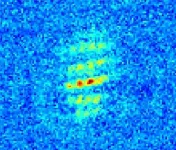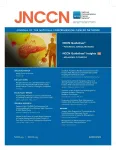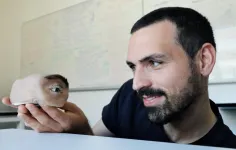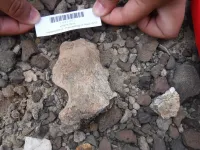Atom interferometry demonstrated in space for the first time
Researchers present results of experiments with atom interferometry on a sounding rocket / Further rocket missions set to follow
2021-04-13
(Press-News.org) Extremely precise measurements are possible using atom interferometers that employ the wave character of atoms for this purpose. They can thus be used, for example, to measure the gravitational field of the Earth or to detect gravitational waves. A team of scientists from Germany has now managed to successfully perform atom interferometry in space for the first time - on board a sounding rocket. "We have established the technological basis for atom interferometry on board of a sounding rocket and demonstrated that such experiments are not only possible on Earth, but also in space," said Professor Patrick Windpassinger of the Institute of Physics at Johannes Gutenberg University Mainz (JGU), whose team was involved in the investigation. The results of their analyses have been published in Nature Communications.
A team of researchers from various universities and research centers led by Leibniz University Hannover launched the MAIUS-1 mission in January 2017. This has since become the first rocket mission on which a Bose-Einstein condensate has been generated in space. This special state of matter occurs when atoms - in this case atoms of rubidium - are cooled to a temperature close to absolute zero, or minus 273 degrees Celsius. "For us, this ultracold ensemble represented a very promising starting point for atom interferometry," explained Windpassinger. Temperature is one of the determining factors, because measurements can be carried out more accurately and for longer periods at lower temperatures.
Atom interferometry: Generating atomic interference by spatial separation and subsequent superposition of atoms
During the experiments, the gas of rubidium atoms was separated using laser light irradiation and then subsequently superpositioned. Depending on the forces acting on the atoms on their different paths, several interference patterns can be produced, which in turn can be used to measure the forces that are influencing them, such as gravity.
Laying the groundwork for precision measurements
The study first demonstrated the coherence, or interference capability, of the Bose-Einstein condensate as a fundamentally required property of the atomic ensemble. To this end, the atoms in the interferometer were only partially superimposed by means of varying the light sequence, which, in the case of coherence, led to the generation of a spatial intensity modulation. The research team has thus demonstrated the viability of the concept, which may lead to further experiments targeting the measurement of the Earth's gravitational field, the detection of gravitational waves, and a test of Einstein's equivalence principle.
Even more measurements will be possible when MAIUS-2 and MAIUS-3 are launched
In the near future, the team wants to go further and investigate the feasibility of high-precision atom interferometry to test Einstein's principle of equivalence. Two more rocket launches, MAIUS-2 and MAIUS-3, are planned for 2022 and 2023, and on these missions the team also intends to use potassium atoms, in addition to rubidium atoms, to produce interference patterns. By comparing the free fall acceleration of the two types of atoms, a test of the equivalence principle with previously unattainable precision can be facilitated. "Undertaking this kind of experiment would be a future objective on satellites or the International Space Station ISS, possibly within BECCAL, the Bose Einstein Condensate and Cold Atom Laboratory, which is currently in the planning phase. In this case, the achievable accuracy would not be constrained by the limited free-fall time aboard a rocket," explained Dr. André Wenzlawski, a member of Windpassinger's research group at JGU, who is directly involved in the launch missions.
The experiment is one example of the highly active research field of quantum technologies, which also includes developments in the fields of quantum communication, quantum sensors, and quantum computing.
The MAIUS-1 sounding rocket mission was implemented as a joint project involving Leibniz University Hannover, the University of Bremen, Johannes Gutenberg University Mainz, Universität Hamburg, Humboldt-Universität zu Berlin, the Ferdinand-Braun-Institut in Berlin, and the German Aerospace Center (DLR). Financing for the project was arranged by the Space Administration of the German Aerospace Center and funds were provided by the German Federal Ministry for Economic Affairs and Energy on the basis of a resolution of the German Bundestag.
INFORMATION:
Related links:
https://www.qoqi.physik.uni-mainz.de/ - Experimental Quantum Optics and Quantum Information research group at the JGU Institute of Physics
Read more:
https://www.uni-mainz.de/presse/aktuell/6645_ENG_HTML.php - press release "Bose-Einstein condensate generated in space for the first time" (31 Oct. 2018) ;
http://www.magazin.uni-mainz.de/8106_ENG_HTML.php - JGU MAGAZINE: "Pioneering measurements in space " (17 Feb. 2017) ;
http://www.uni-mainz.de/presse/aktuell/260_ENG_HTML.php - press release "Experiment involving ultracold rubidium lifts off with research rocket" (2 Feb. 2017) ;
https://www.uni-mainz.de/presse/20917_ENG_HTML.php - press release "Laser system co-developed by Mainz scientists passes test in space" (25 Jan. 2016)
[Attachments] See images for this press release:

ELSE PRESS RELEASES FROM THIS DATE:
2021-04-13
Scientists at the Walter Reed Army Institute for Research demonstrated the potential of a novel blood test for cathepsin B, a well-studied protein important to brain development and function, as an indicator for a range of disease states.
Cathepsin B plays an important role in the body, regulating the metabolism, immune responses, degradation of improperly produced proteins and other functions. Under certain conditions, such as metastatic cancers, infections, trauma and neurological disease, cathepsin B production is upregulated. Recent research published by WRAIR researchers highlighted the potential of cathepsin B as an indicator, or biomarker, of the severity of traumatic brain injury.
In this study, published in ACS Omega, researchers demonstrated an ultrasensitive ...
2021-04-13
It cannot be denied that, over the past few decades, the miniaturization of electronic devices has taken huge strides. Today, after pocket-size smartphones that could put old desktop computers to shame and a plethora of options for wireless connectivity, there is a particular type of device whose development has been steadily advancing: wearable biosensors. These tiny devices are generally meant to be worn directly on the skin in order to measure specific biosignals and, by sending measurements wirelessly to smartphones or computers, keep track of the user's health.
Although materials scientists have developed many types ...
2021-04-13
Researchers from North Carolina State University have found a way to fine-tune the molecular assembly line that creates antibiotics via engineered biosynthesis. The work could allow scientists to improve existing antibiotics as well as design new drug candidates quickly and efficiently.
Bacteria - such as E. coli - harness biosynthesis to create molecules that are difficult to make artificially.
"We already use bacteria to make a number of drugs for us," says Edward Kalkreuter, former graduate student at NC State and lead author of a paper describing the ...
2021-04-13
University of Maryland School of Medicine (UMSOM) researchers have shown that psilocybin--the active chemical in "magic mushrooms"-- still works its antidepressant-like actions, at least in mice, even when the psychedelic experience is blocked. The new findings suggest that psychedelic drugs work in multiple ways in the brain and it may be possible to deliver the fast-acting antidepressant therapeutic benefit without requiring daylong guided therapy sessions. A version of the drug without, or with less of, the psychedelic effects could loosen restrictions on who could receive the therapy, and lower costs, making the benefits of psilocybin more available to more people in need.
In all clinical ...
2021-04-13
The "three-body problem," the term coined for predicting the motion of three gravitating bodies in space, is essential for understanding a variety of astrophysical processes as well as a large class of mechanical problems, and has occupied some of the world's best physicists, astronomers and mathematicians for over three centuries. Their attempts have led to the discovery of several important fields of science; yet its solution remained a mystery.
At the end of the 17th century, Sir Isaac Newton succeeded in explaining the motion of the planets around the sun through ...
2021-04-13
PLYMOUTH MEETING, PA [April 13, 2021] -- The April 2021 issue of JNCCN--Journal of the National Comprehensive Cancer Network publishes new research from Memorial Sloan Kettering Cancer Center (MSK) and Gustave Roussy Institute, which suggests that baseline brain imaging should be considered in most patients with metastatic kidney cancer. The researchers studied 1,689 patients with metastatic renal cell carcinoma (mRCC) who had been considered for clinical trial participation at either of the two institutions between 2001 and 2019 and had undergone brain imaging in this context, without clinical suspicion for brain involvement. The researchers discovered 4% had asymptomatic brain metastases in this setting. This group was found to have a low median 1-year ...
2021-04-13
ITHACA, N.Y. - We've all seen them: political ads on television that promise doom gloom if Candidate X is elected, and how all your problems will be solved if you choose Candidate Y. And Candidate Y, of course, approves this message.
Beyond attempting to move a large swath of the population to vote one way or another, the seemingly constant bombardment of negativity in the name of our democratic process is anxiety-inducing, researchers have found.
"Many of my friends and family members wind up quite stressed out, for lack of a better word, during each election season," said Jeff Niederdeppe, professor in the Department of Communication in the College of ...
2021-04-13
With 'Eyecam' they now present the prototype of a webcam that not only looks like a human eye, but imitates its movements realistically. "The goal of our project is not to develop a 'better' design for cameras, but to spark a discussion. We want to draw attention to the fact that we are surrounded by sensing devices every day. That raises the question of how that affects us," says Marc Teyssier. In 2020, the French scientist completed his doctorate on the topic of anthropomorphic design in Paris. Now he is a postdoctoral researcher in the Human-Computer Interaction Lab at Saarland University in Germany.
The research team at Saarland Informatics Campus has developed ...
2021-04-13
Human non-alcoholic fatty liver disease (NAFLD) is a little-understood condition that significantly increases the risk of inflammation, fibrosis and liver cancer and ultimately requires liver transplant.
"NAFLD has been difficult to study mainly because we had no good animal model," said corresponding author Dr. Karl-Dimiter Bissig, who was at Baylor during the development of this project and is now at Duke University.
The disease has both genetic and nutritional components, which have been hard to understand in human studies, and murine models ...
2021-04-13
A new study verifies the age and origin of one of the oldest specimens of Homo erectus--a very successful early human who roamed the world for nearly 2 million years. In doing so, the researchers also found two new specimens at the site--likely the earliest pieces of the Homo erectus skeleton yet discovered. Details are published today in the journal Nature Communications.
"Homo erectus is the first hominin that we know about that has a body plan more like our own and seemed to be on its way to being more human-like," said Ashley Hammond, an assistant curator in the American Museum of Natural History's Division of Anthropology and the lead author of the new study. "It had longer lower limbs than upper limbs, a torso ...
LAST 30 PRESS RELEASES:
[Press-News.org] Atom interferometry demonstrated in space for the first time
Researchers present results of experiments with atom interferometry on a sounding rocket / Further rocket missions set to follow



